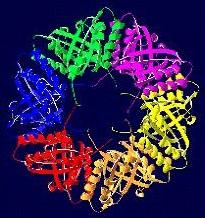The protein may be used in a complex of developments such as cancer treatment, medical diagnosis, nanoelectronics and plant improvement

SP-1 protein-like. Illustration: The Hebrew University
Direct link to this page: https://www.hayadan.org.il/huji060105.html
Researchers from the Hebrew University isolated a new protein from poplar plants with unique properties, called SP-1. The protein consists of basic units that have the ability to self-assemble, forming a symmetric, nanometer-like structure. The uniqueness of the protein is its resistance to extreme conditions: the protein retains its structure and properties even after long boiling, exposure to enzymes that digest and break down normal proteins and extreme conditions of acidity, salt and detergents.
The research was carried out by Prof. Aryeh Altman, head of the Robert H. Smith Institute of Plant Sciences and Genetics in Agriculture at the Faculty of Agriculture of the Hebrew University, and Prof. Oded Shusiev from the Faculty of Agriculture, with the participation of research students Dr. Vangshia Wang and Dr. Dan Falah.
According to Prof. Altman and Prof. Shusiov, the SP-1 protein serves as a special protein that enables the folding and creation of a normal and active structure of other proteins in the cell. The new protein has the ability to self-assemble to form a protein consisting of a dozen identical units and is exceptionally resistant to extreme conditions. The combination of all these features in one protein is rare and therefore enables the use of the protein in a complex of medical and nano-biotechnological developments.
Today it is known that drugs that are toxic to dividing cells and used to suppress certain types of cancer can be bound to the protein. Due to the tiny size of the protein, the stability and binding capacity of the drug, this carrier of drugs can penetrate the target site of the tumors, but not the healthy tissues, thus optimizing the chemotherapy treatment. This selective penetration is based on the fact that the blood vessels that reach the cancerous tumors have considerably larger pores than those that reach healthy tissues - therefore, the SP-1 units that carry the drug will only penetrate the tumors.
Recently, the spatial structure of the protein has also been deciphered, based on the complete identification of the amino acid sequence. The research published in December 2004 in the prestigious Journal of Biological Chemistry was done by Prof. Altman, Prof. Shusiov and doctoral student Or Dagani, in collaboration with Dr. Orna Almog from Ben Gurion University, Dr. Sharon Wolf from the Weizmann Institute of Science and other researchers.
Prof. Aryeh Altman and Prof. Oded Shusiov are the founding scientists of the start-up biotechnological company Fulchrome Ltd. and are currently engaged in the development of the protein as a carrier of drugs for targeted transport to solid cancerous tumors.
In addition to this, the researchers are trying to examine other uses of the SP-1 protein, including genetic engineering of plants to increase their resistance to the stress of salinity and dryness, applications in nano-bioelectronics, materials science (for example, to create nanometer coatings) and more.
They know nano technology
https://www.hayadan.org.il/BuildaGate4/general2/data_card.php?Cat=~~~41541378~~~57&SiteName=hayadan
